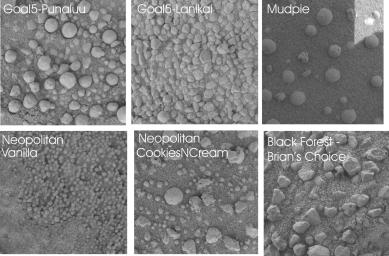No Two Soil Patches Are Alike
Caption:
This mosaic of microscopic images (each about two centimeters by two centimeters or .8 inches by .8 inches) from the Mars Exploration Rover Opportunity illustrates the tremendous variety of soil types and shapes observed by the science team during the recent "Eagle Crater" five-target soil survey. Scientists are working to understand the sorting mechanisms that have distributed the various soil types. The survey was conducted from sol 52 to sol 56.
"Punaluu's" largest particles are similar to those seen in the "Eagle Crater" outcrop (see also
PIA05640
). There are also some smaller, more irregular rounded particles that have likely been transported by wind. The "Lanikai" target reveals irregularly shaped, light-colored, millimeter-sized (0.04 inch-sized) clasts, or particles, in a fine-grained soil (see also
PIA05646
). Lanikai's angular, less-rounded clast shapes interested the science team when compared to other soil targets in the crater area studied by the microscopic imager. The image of "Neopolitan" highlights the border between two different soil types - a lighter, finer-grained unit to the left and a darker, coarser-grained to the right (see also
PIA05648
). Scientists are pondering the unusually distinct border between these different soil types. "Cookies and Cream" (see also
PIA05649
) is a mixture of light and dark soil units in the "Neopolitan" area. There are several different types of clasts, or particles, held in surrounding fine-grained sands: rounded spherules, angular, irregular fragments (containing what are presumably vesicles or small cavities) and smaller, about one millimeter-sized (0.04 inch-sized), rounded clasts. At "Vanilla," the microscopic images have revealed small grains one millimeter (0.04 inch) or less in size and somewhat lighter in color than those in other soil units observed in the crater (see also
PIA05650
). "Mudpie" is representative of the soils lower in the crater, a fair distance from the outcrop. It contains spherules and irregularly shaped vesicles held in a dark sand. In the "Black Forest" area at the target referred to as "Brian's Choice" are irregularly shaped clasts, low in hematite content based on miniature thermal emission spectrometer readings. Presumably, the particles in this area are more affected by winds since they are on the outer part of crater and are likely deposited and re-distributed by wind on a fairly frequent basis.
Cataloging Keywords:
| Name |
Value |
Additional Values |
| Target |
Mars |
|
| System |
|
|
| Target Type |
Planet |
|
| Mission |
Mars Exploration Rover (MER) |
|
| Instrument Host |
Opportunity (MER-B) |
|
| Host Type |
Rover |
|
| Instrument |
Microscopic Imager (MI) |
|
| Detector |
|
|
| Extra Keywords |
Crater, Grayscale, Thermal |
| Acquisition Date |
|
| Release Date |
2004-03-27 |
| Date in Caption |
|
|
| Image Credit |
NASA/JPL/Cornell/USGS |
| Source |
photojournal.jpl.nasa.gov/catalog/PIA05651 |
| Identifier |
PIA05651 |

 Planetary Data System
Planetary Data System
